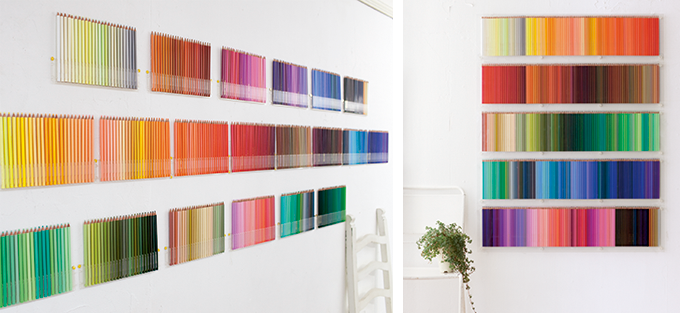Advanced edition #03 Color name
Characteristics of color names and points to note when using them
We explained the system used to convey color. A slightly more common way of communicating is "color name."
There are different ways of expressing color names, such as basic color names, systematic color names, unique color names, and conventional color names.
- The basic color name is the name of the color that is the basis for expressing the color in words.
- Systematic color names are a way of expressing colors by adding modifiers such as "bright," "dark," and "gray" to basic color names such as red, yellow, green, blue, white, gray, and black. . There are JIS color names, PCCS color names, etc.
- A unique color name is a color name that is given using the names of things associated with the color, such as the names of raw materials such as pigments and dyes, as well as animals, plants, minerals, natural phenomena, people's names, and place names. Unique color names also include traditional color names and customary color names that have been used in everyday life for a long time.
- Conventional color names are relatively well-known and widely used color names among unique color names.
Now, if we look at our daily life, it is a common practice to refer to colors by name. As long as you are both in the same place and looking at the same thing, you will be able to communicate well and feel no inconvenience.
However, it is best to be a little careful when using color names.
The JIS (Japanese Industrial Standards) indicates Munsell values for commonly used color names, but they are only a guideline, and it is better to understand that when a color is indicated by a name, it is a "range". That's fine. For example, the range of people who think "red" is red is quite wide.
The figure below shows the ranges that are likely to appear when you select a color chart for the names "pink" and "navy blue." For art students and people involved in design, the results will be more convergent, but for people in general occupations, the results may spread over a wider range than shown here.

If you buy based on the color name, you may end up complaining that the color is not what you expected. Also, even if you ask about colors that are popular this year, you may not be able to tell just from the name of the color. Since the 130 colors shown here are too large to handle, many companies create color code tables for each company and use the data as data.
Color names that vary by region and culture
The expression and range of colors seem to vary depending on the culture. Even if there is an expression called an orange car, in English it is a color name that refers to a wide range of colors, and in the Japanese sense it is brown.
Many of Japan's traditional color names are derived from plants or flowers, and I feel that they are influenced by the climate and climate with its rich vegetation. In comparison, English and French color names are often named after food or drinks. Color names in China are often mineral expressions. In addition, in Japan, the color brown was popular during the Edo period, where the color brown was named after an actor, but in France, the color brown was named after a woman who led the social world. I think. The exhibition in Madame Pompadour's room at the Louvre Museum was covered in pink and was spectacular.

The following example is an easy-to-understand example of the difference in color names.
In Japanese, ``Momoiro'' is also written as ``Momokairo,'' indicating the color of the flower. In comparison, the literal translation of peach is Peach, which is a color name that refers to the color of the peach's flesh. People have become accustomed to the word peach, as it has been used as a color name in cosmetics, and in beverages with a peach scent, so it can be said that the difference in color names has become widely known. When a color name is used in a product name or advertising copy, it seems that the color name becomes popular all at once. Conversely, it can be said that the name of a color that is not familiar can be used repeatedly to greatly increase the advertising effect.

era and color name
Let's take a look at the color names in Japan in 1944. The authors are concerned about the loss of the colors that Japan has cherished so far during the war, and have decided to introduce representative colors with samples.
- Red-orange lineage: Suho, red plum, Korean safflower, peach blossom, cherry blossom, meat, red Suho, silver vermilion, shojihi, red scarlet, yellow tan, true scarlet, soi (sohi), persimmon, deep branch, Citrus, rotten leaves, red and white oak, azuki beans, grape tea, cinnabar, cypress bark, red citrus, red citron
- Tea system/ dark brown, chestnut bark, tobi, kama, yellow oak dyeing, clove tea, shiba, clove, cypress yellow, khaki, mulberry, yellow mulberry, incense, ocher
- Yellow lineage/ Yamabuki, Fujio, Yukine, Kariyasu, Obaku, Suiko, Tamago
- Green system: Japanese nightingale, Japanese nightingale, Japanese nightingale, Japanese nightingale, Moe yellow, green, verdigris, white green, pine needle, Japanese indigo, sea pine, aphrodisiac tea, blue and white oak
- Blue series/ Eggplant navy blue, navy blue, nato, navy blue, glass, gunjo, white gun, tan, light yellow
- Purple series: dark purple, deep purple, two indigo, purple, grape, deep scarlet, bellflower, wisteria, peony
- Black Rat lineage/Sumi, Kuroki, Akatsuki, Dull, Blue Dull, Rikyu Rat, Ash
Bold text is added by the author, and is currently ``color names known to university students.''
Source: Co-authored by Rokuro Uemura and Katsuhiro Yamazaki, ``Japanese color name dictionary'', 1944, Kochoshorin
I think it's hard to read because it's all about kanji. Among the colors that are classified as brown, in modern times there are also colors that could be classified as yellow, indicating that in the past, the range of hues represented by "brown" was wide. . The way we perceive color names seems to change over time, so I think it's interesting and needs to be treated with care.
I have bolded the color names that students still know today. Traditional color names used to exist in the past and were named to represent them, but in modern times they have disappeared and it is difficult to imagine what they are referring to. there is. Color names that can still be seen around us, such as the colors of plants and flowers, seem to have survived.
However, just as the authors Kamimura and Yamazaki did their best in an era when supplies were scarce, I believe that even today there are many people who love Japanese culture, colors, and color names. Furthermore, traditional color names are interesting and represent not only Japan but various regions and cultures, so I hope that research will become more active.
Color names that make the most of the product


Color names now
The color names written in fashion magazines these days are actually very unstable. The color of the light source when taking the photo affects the color of the photo, and some colors tend to be misaligned when printing, so the color name written there and the color of the photo often mismatch. did.
Perhaps reflecting this fact, when I look at recent fashion magazines aimed at young women, I feel that they don't use very detailed color names. We see expressions such as white, gray, black, and red, but other expressions are used to indicate direction, such as dark colors and beautiful colors. Also, in the corner where pastels are popular, like the color system names, they are categorized into pink, blue, yellow, orange, green, and purple and are introduced in pale tones. There are cases where pale blue is modified with adjectives that express the atmosphere, such as innocent blue or good child blue. In today's world, is it more appropriate to express basic color names or very common idiomatic color names by adding adjectives that express the atmosphere, rather than using proper noun-like color names? This is also an attractive expression of color.
On the other hand, when it comes to works aimed at madams, on the contrary, very detailed expressions are attempted, which is surprising. Yellow beige, pink beige, khaki beige, orange beige, camel beige, sand beige, blue beige, gray beige. Color names may be becoming increasingly polarized between those who like them and are familiar with them, and those who are not interested in them.
The way colors are expressed by name changes with the times, and seems to take on the power of being reminiscent of that era. Rather than just memorizing color names for educational purposes, I would like to focus on their characteristics and their power to make an impression on people, and use them more actively.
April 21, 2016
Text by Japan Color Design Institute
